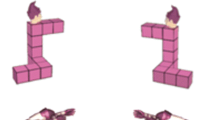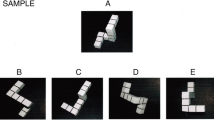Abstract
Gender differences in mental-rotation tests with cube figures as rotational material are well examined and robust. Besides biological or socialization factors, task characteristics could partly be responsible for men’s advantage in mental rotation. Therefore, we investigated in two studies the influence of different rotational materials on the gender differences in mental-rotation performance. In the first study, 134 undergraduate students (89 women, 45 men) participated using a mental-rotation test with either cube or pellet figures. Significant gender differences in favour of men but no interaction of gender and material were found. In the second study, 189 undergraduate students (110 women, 79 men) solved a mental-rotation test with either male or female-stereotyped objects. Significant gender differences appeared only when male-stereotyped objects were used as rotational material, but not for female-stereotyped material. A significant interaction of gender and material appeared. Hence, some rotational objects seem to have an influence on participants’ mental-rotation performance and the gender differences in this task while others do not affect performances of women and men.



Similar content being viewed by others
Availability of data and material
Data will be made available.
References
Alexander, G. M., & Evardone, M. (2008). Blocks and bodies: Sex differences in a novel version of the Mental Rotations Test. Hormones and Behavior, 53(1), 177–184.
Alexander, G. M., & Son, T. (2007). Androgens and eye movements in women and men during a test of mental rotation ability. Hormones and Behavior, 52(2), 197–204.
Bethell-Fox, C. E., & Shepard, R. N. (1988). Mental rotation: Effects of stimulus complexity and familiarity. Journal of Experimental Psychology: Human Perception and Performance, 14(1), 12.
Chatterjee, A. (2008). The neural organization of spatial thought and language. Seminars in Speech and Language, 29(3), 226–238.
Collins, D. W., & Kimura, D. (1997). A large sex difference on a two-dimensional mental rotation task. Behavioral Neuroscience, 111(4), 845.
Doyle, R. A., & Voyer, D. (2013). Bodies and occlusion: Item types, cognitive processes, and gender differences in mental rotation. The Quarterly Journal of Experimental Psychology, 66(4), 801–815.
Doyle, R. A., & Voyer, D. (2016). Stereotype manipulation effects on math and spatial test performance: a meta-analysis. Learning and Individual Differences, 47, 103–116.
Doyle, R. A., & Voyer, D. (2018). Photographs of real human figures: Item types and persistent sex differences in mental rotation. Quarterly Journal of Experimental Psychology, 71(11), 2411–2420. https://doi.org/10.1177/1747021817742079.
Doyle, R. A., Voyer, D., & Lesmana, M. (2016). Item type, occlusion, and gender differences in mental rotation. The Quarterly Journal of Experimental Psychology, 69(8), 1530–1544.
Faul, F., Erdfelder, E., Lang, A. G., & Buchner, A. (2007). G* Power 3: a flexible statistical power analysis program for the social, behavioral, and biomedical sciences. Behavior Research Methods, 39(2), 175–191.
Fisher, M. L., Meredith, T., & Gray, M. (2018). Sex differences in mental rotation ability are a consequence of procedure and artificiality of stimuli. Evolutionary Psychological Science, 4(2), 124–133.
Gauthier, I., Hayward, W. G., Tarr, M. J., Anderson, A. W., Skudlarski, P., & Gore, J. C. (2002). BOLD activity during mental rotation and viewpoint-dependent object recognition. Neuron, 34(1), 161–171.
Grimshaw, G. M., Sitarenios, G., & Finegan, J. A. K. (1995). Mental rotation at 7 years-relations with prenatal testosterone levels and spatial play experiences. Brain and Cognition, 29(1), 85–100.
Hausmann, M., Schoofs, D., Rosenthal, H. E., & Jordan, K. (2009). Interactive effects of sex hormones and gender stereotypes on cognitive sex differences—a psychobiosocial approach. Psychoneuroendocrinology, 34(3), 389–401.
Heil, M., Jansen, P., Quaiser-Pohl, C., & Neuburger, S. (2012). Gender-specific effects of artificially induced gender beliefs in mental rotation. Learning and Individual Differences, 22(3), 350–353.
Heil, M., & Jansen-Osmann, P. (2008). Sex differences in mental rotation with polygons of different complexity: Do men utilize holistic processes whereas women prefer piecemeal ones? Quarterly Journal of Experimental Psychology, 61(5), 683–689.
Jansen, P., & Lehmann, J. (2013). Mental rotation performance in soccer players and gymnasts in an object-based mental rotation task. Advances in Cognitive Psychology, 9(2), 92.
Jansen-Osmann, P., & Heil, M. (2007). Suitable stimuli to obtain (no) gender differences in the speed of cognitive processes involved in mental rotation. Brain and Cognition, 64(3), 217–227.
Kozhevnikov, M., & Hegarty, M. (2001). A dissociation between object manipulation spatial ability and spatial orientation ability. Memory and Cognition, 29(5), 745–756.
Kozhevnikov, M., Kosslyn, S., & Shephard, J. (2005). Spatial versus object visualizers: a new characterization of visual cognitive style. Memory and Cognition, 33(4), 710–726.
Linn, M. C., & Petersen, A. C. (1985). Emergence and characterization of sex differences in spatial ability: a meta-analysis. Child Development, 56, 1479–1498.
Moè, A. (2009). Are males always better than females in mental rotation? Exploring a gender belief explanation. Learning and Individual Differences, 19(1), 21–27.
Moè, A., & Pazzaglia, F. (2006). Following the instructions!: effects of gender beliefs in mental rotation. Learning and Individual Differences, 16(4), 369–377.
Neuburger, S., Jansen, P., Heil, M., & Quaiser-Pohl, C. (2012). A threat in the classroom. Gender stereotype activation and mental-rotation performance in elementary-school children. Zeitschrift für Psychologie, 220(2), 61–69.
Newcombe, N., & Shipley, T. (2015). Thinking about spatial thinking: new typology, new assessments. In J. Gero (Ed.), Studying Visual and Spatial Reasoning for Design Creativity. Dordrecht: Springer.
Quinn, P. C., & Liben, L. S. (2014). A sex difference in mental rotation in infants: convergent evidence. Infancy, 19(1), 103–116.
Rahe, M., & Quaiser-Pohl, C. (2019). Mental-rotation performance in middle and high-school age: influence of stimulus material, gender stereotype beliefs, and perceived ability of gendered activities. Journal of Cognitive Psychology, 31(5–6), 594–604.
Rahe, M., & Quaiser-Pohl, C. (2020). Cubes or pellets in mental-rotation tests: effects on gender differences and on the performance in a subsequent math test. Behavioral Sciences, 10(1), 12.
Rahe, M., Ruthsatz, V., Jansen, P., & Quaiser-Pohl, C. (2018). Influence of sex-stereotyped stimuli on the mental-rotation performance of elderly persons. Experimental Aging Research, 44(4), 284–296.
Ruthsatz, V., Neuburger, S., Jansen, P., & Quaiser-Pohl, C. (2014). Pellet figures, the feminine answer to cube figures? Influence of stimulus features and rotational axis on the mental-rotation performance of fourth-grade boys and girls. In C. Freksa, B. Nebel, M. Hegarty, & T. Barkowsky (Eds.), International Conference on Spatial Cognition (pp. 370–382). Cham: Springer.
Ruthsatz, V., Neuburger, S., Jansen, P., & Quaiser-Pohl, C. (2015). Cars or dolls? Influence of the stereotyped nature of the items on children’s mental-rotation performance. Learning and Individual Differences, 43, 75–82.
Ruthsatz, V., Neuburger, S., Rahe, M., Jansen, P., & Quaiser-Pohl, C. (2017). The gender effect in 3D-Mental-rotation performance with familiar and gender-stereotyped objects–a study with elementary school children. Journal of Cognitive Psychology, 29(6), 717–730.
Ruthsatz, V., Rahe, M., Schüermann, L., & Quaiser-Pohl, C. (2019). Girls’ stuff, boys’ stuff and mental rotation: fourth graders rotate faster with gender-congruent stimuli. Journal of Cognitive Psychology, 31(2), 225–239.
Shepard, R. N., & Metzler, J. (1971). Mental rotation of three-dimensional objects. Science, 171, 701–703.
Steele, C. M., & Aronson, J. (1995). Stereotype threat and the intellectual test performance of African Americans. Journal of Personality and Social Psychology, 69(5), 797.
Uttal, D. H., Meadow, N. G., Tipton, E., Hand, L. L., Alden, A. R., Warren, C., & Newcombe, N. S. (2013). The malleability of spatial skills: a meta-analysis of training studies. Psychological Bulletin, 139(2), 352–402.
Vandenberg, S. G., & Kuse, A. R. (1978). Mental rotations, a group test of three-dimensional spatial visualization. Perceptual and Motor Skills, 47(2), 599–604.
Voyer, D. (2011). Time limits and gender differences on paper-and-pencil tests of mental rotation: a meta-analysis. Psychonomic Bulletin and Review, 18(2), 267–277.
Voyer, D., Voyer, S., & Bryden, M. P. (1995). Magnitude of sex differences in spatial abilities: a meta-analysis and consideration of critical variables. Psychological Bulletin, 117(2), 250.
Walton, G. M., & Cohen, G. L. (2003). Stereotype lift. Journal of Experimental Social Psychology, 39(5), 456–467.
Funding
We received no funding.
Author information
Authors and Affiliations
Corresponding author
Ethics declarations
Conflict of interest
We declare that we have no conflicts of interest.
Ethics approval
The experiment was conducted according to the ethical guidelines of the Helsinki declaration. Ethical approval for this study was not required in accordance with the conditions outlined by the German Research Foundation where research that carries no additional risk beyond daily activities does not require Research Ethics Board Approval.
Consent to participate
All participants gave their informed consent.
Additional information
Publisher's Note
Springer Nature remains neutral with regard to jurisdictional claims in published maps and institutional affiliations.
Rights and permissions
About this article
Cite this article
Rahe, M., Ruthsatz, V. & Quaiser-Pohl, C. Influence of the stimulus material on gender differences in a mental-rotation test. Psychological Research 85, 2892–2899 (2021). https://doi.org/10.1007/s00426-020-01450-w
Received:
Accepted:
Published:
Issue Date:
DOI: https://doi.org/10.1007/s00426-020-01450-w




